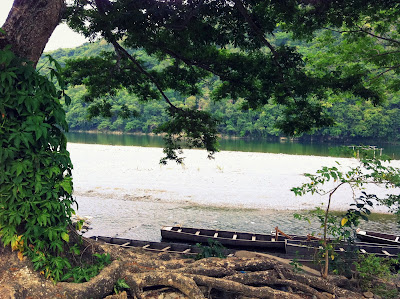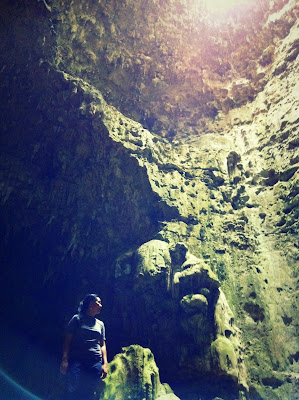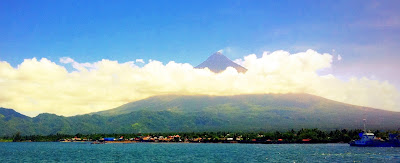You know that pit-stop scene in an F1 race
when the car stops for a quick change of tire? That's like what
happened to us. We got back to San Vicente shore from a night at Crocodile Island and heard that a boat was on its
way to pick up tourists at Nangamaroan. We ate breakfast and off we went again for a free ride, courtesy of my-new-uncle Nanding (see previous entry).
Our gracious boatmen hosts brought us across the mangroves just to show us how beautiful their place is. There's something exhilarating looking at a place the way the locals see it. The pride. The love. My heart expands to take in the beauty of it all. The world shines a little more brilliant, life is promising, and my heart weighs heavier with love. And you believe that THE WORLD IS AWESOME.
Our gracious boatmen hosts brought us across the mangroves just to show us how beautiful their place is. There's something exhilarating looking at a place the way the locals see it. The pride. The love. My heart expands to take in the beauty of it all. The world shines a little more brilliant, life is promising, and my heart weighs heavier with love. And you believe that THE WORLD IS AWESOME.
Touchdown was at Nangamaroan Beach. A white stretch of fine-sand beach kissing the tamed aqua-blue sea. The water is calm and shallow with a sprinkle of boulders heading to the sea. It has the Sierra Madre Range guarding its left flank, but as you look out towards the ocean, there's nothing but the endless sea in the horizon. Out there would be where South China Sea meets the Philippine Sea. And further beyond is the North Pacific Ocean.
 |
| Nangamaroan Beach |
 |
| Nangamaroan Beach |
Near the edge of the beach are cottages to sleep at night and nipa huts to hang out during the day. There are some small places to eat --yes, there's halo-halo with their famous caramel topping-- and pay restrooms as well, and even the ever-present karaoke machine unfortunately did not miss this place.
We didn't stay here but pushed for the "disputed" Anguib Beach. It didn't take 15-minutes from the time we sat on the sands of Nangamaroan Beach
before the locals started talking of a land-dispute issue. The
rich-and-politically-powerful VS those who have had their ancestors root from that place at the turn of the 20th century. By saying this, I've probably already gotten a few of them in danger . . . but the truth must be named.
 |
| hitching a ride with the locals |
I am always intrigued by disputes like this. Only beautiful and prosperous places ever gets disputed on. And so, taking a tricycle-sidecar-ride-to-the-death, we headed to Anguib Beach. I say that because that's certainly what it felt like. The way, although well-paved, is steep, overlooking the ocean. The old tricycle our host was using could barely take all 5 of us through the rolling and turning road. When we started skidding and drifting *LOL* I decided to just walk under the heat of the midday sun.
Lucky me, there was a truck on its way to Golden Beach, so I hitched a ride with the locals and found myself standing at the fringe of that long stretch of that white-sand shoreline we spotted from the boat on our way there.
 |
| We found what we were looking for |
That was it. We found what we were looking for. We unloaded our packs and said, "we're staying".
We watched the tide expose the sea grass as the day wore on and turn the beach into a long stretch of sandbar kilometers-long. The sea became a distant view from our little nipa hut as the day attempted to lull us to sleep. But I am not one to let the heat and stink --yes, the expose shore had that fishy smell to it-- get to me. I took the opportunity to explore the exposed shore and crossed as far as I could walk perpendicular to the beach. There was about a hundred pictures taken from this place alone.
 |
| Anguib Beach |
Once again, we pitched our tent and waited for the light-show of the approaching darkness, exchanging world-view and two-cents' worth on love and life. What was challenging in the night though was the nik-nik that came with the dusk. These teeny-tiny insects that can make your hair stand on its ends as they swarm over all your exposed skin, biting and biting and biting until your eyes get all teary and you begin to hyperventilate.
 |
| light-show of the approaching darkness |
We did a quick-but-not-so-effective fix by covering up and lavishing our arms and legs with insect-off lotion. The resort owner saw our distress and woke up a fire with young leaves and tender twigs, the smoke it made gave us some relief as it kept the nik-niks at bay. Unfortunately though, it also made us feel like smoked-fish. Well, it's either that, or go crazy.
I haven't had enough twilight still so I set an alarm to wake up at 5AM and watch the sky turn colors with my favorite shade -- violet, purple, mauve and everything else in between as the sun rose. Ahhhhh absolutely beautiful!
 |
| the sky turning into my favorite shades as the sun rose |
The afternoon before brought the tide back in and it stayed until the rest of the morning. As you can see from the pictures below, I'm all brown from the sun. I sat there and wondered how long I can sustain a life like this . . . if only.
 |
| how long can I sustain a life like this? |
But our funds had ran out. Time is ticking. And we still had 16-hours of road trip before us, heading back to Manila. I bid farewell to the beach and patiently waited --with a touch of dread-- for new boatmen arranged to take us back to San Vicente (thanks once again to my new-uncle Nanding, who was overly kind enough to ask one of the boats to come pick us up, for FREE!)
 |
| bidding farewell to the beach -- patiently waiting for our boatman |
Nothing to be done for things that must end. So when the boat came, I took it on as a start to another adventure -- you can see how I stood on that little boat, leaving Anguib Beach and once again be awed by the seascape we passed through on our way back to the port of San Vicente.
 |
| to a start of another adventure . . . |
I can't thank our host from the PASAMOBA BOAT ASSOCIATION enough for the wonderful time we had in their part of the country. If you decide to go this way, let me know so I can give you their contact information and be extended with the same grand gestures that were shown to us when we were there.
 | |||
| our hosts from the PASAMOBA BOAT ASSOCIATION |
Read the Roadtrip sa Norte series of entries:












































